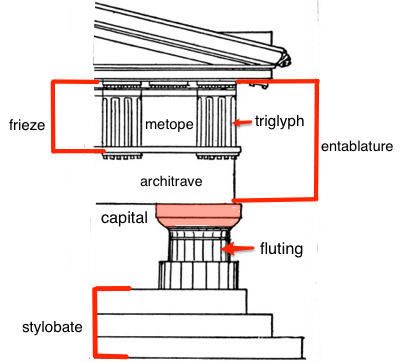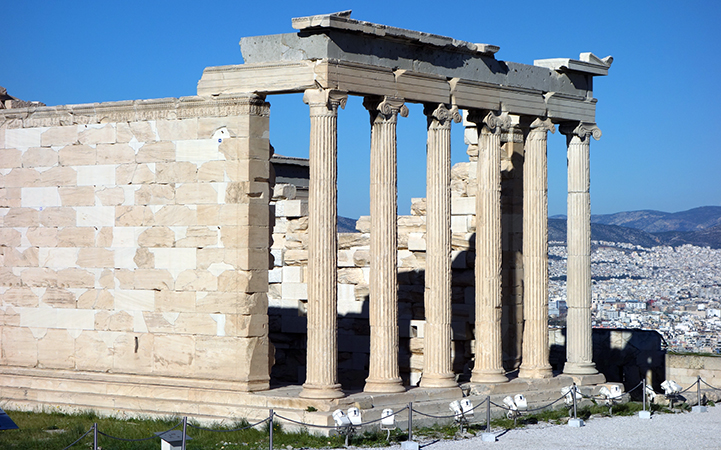The Doric order
The Doric order is the earliest of the three Classical orders of architecture and represents an important moment in Mediterranean architecture when monumental construction made the transition from impermanent materials—like wood—to permanent materials, namely stone. The Doric order is characterized by a plain, unadorned column capital and a column that rests directly on the stylobate of the temple without a base. The Doric entablature includes a frieze composed of trigylphs—vertical plaques with three divisions—and metopes—square spaces for either painted or sculpted decoration. The columns are fluted and are of sturdy, if not stocky, proportions.
The Ionic order
As its names suggests, the Ionic order originated in Ionia, a coastal region of central Anatolia—today Turkey—where a number of ancient Greek settlements were located. Volutes, scroll-like ornaments, characterize the Ionic capital, and a base supports the column, unlike the Doric order. The Ionic order developed in Ionia during the mid-sixth century BCE and had been transmitted to mainland Greece by the fifth century BCE. Among the earliest examples of the Ionic capital is the inscribed votive column from Naxos, dating to the end of the seventh century BCE.
c. 570-560 BCE, was the first of the great Ionic buildings, although it was destroyed by earthquake in short order. The sixth century BCE Temple of Artemis at Ephesus, a wonder of the ancient world, was also an Ionic design. In Athens, the Ionic order influenced some elements of the Parthenon, 447-432 BCE, notably the Ionic frieze that encircles the cella of the temple. Ionic columns are also employed in the interior of the monumental gateway to the Acropolis, known as the Propylaia, c. 437-432 BCE. The Ionic was promoted to an exterior order in the construction of the Erechtheion, c. 421-405 BCE, on the Athenian Acropolis, image below.
The Ionic order is notable for its graceful proportions, which produce a more slender and elegant profile than the Doric order. The ancient Roman architect Vitruvius compared the Doric module to a sturdy, male body, while the Ionic was possessed of more graceful, feminine proportions. The Ionic order incorporates a running frieze of continuous sculptural relief, as opposed to the Doric frieze composed of triglyphs and metopes.
The Corinthian order
The defining element of the Corinthian order is its elaborate, carved capital, which incorporates even more vegetal elements than the Ionic order does. The stylized, carved leaves of an acanthus plant grow around the capital, generally terminating just below the abacus. The Romans favored the Corinthian order, perhaps due to its slender properties. The order is employed in numerous notable Roman architectural monuments, including the Temple of Mars Ultor, the Pantheon in Rome, and the Maison Carrée in Nîmes.
Legacy of the Greek architectural canon
Candela Citations
- Greek Architectural Orders. Authored by: Dr. Jeffrey A. Becker. Provided by: The Khan Academy. Located at: https://www.khanacademy.org/humanities/art-history/ancient-art-civilizations/greek-art/beginners-guide-greece/a/greek-architectural-orders. Project: Greek Architectural Orders. License: CC BY-NC-SA: Attribution-NonCommercial-ShareAlike








